In May 2003, President George W. Bush signed into law his investment tax cut. This package included accelerated reductions in income tax rates, a cut in the dividend tax from 39.6 percent to 15 percent and a reduction in the capital gains tax from 20 percent to 15 percent. The purpose of the Bush tax cut was to provide an incentive for more domestic capital investment, more business spending and a turnaround in the stock market, which lost $6 trillion in value after the technology bubble burst in 1999-2000. The terrorist attacks of September 11, 2001, caused a further plunge in the stock market, a drought of business investment and job layoffs. Bush declared that a change in fiscal policy — particularly tax policy — was necessary to stimulate a fragile economy and avert a long and deep recession similar to what the United States experienced in the late 1970s and early 1980s.
This study examines how the economy has responded to this investment tax stimulus, with special emphasis on the reduction in the tax on capital gains (income from the sale of an investment). It also examines the historical evidence of how the economy has responded to changes in the capital gains tax rate. It concludes that the lower capital gains tax rate has had positive effects on the economy and government finances. The most important of these effects are as follows:
- The rate of business capital investment has undergone a U-turn — from negative business investment spending in the two years before the tax cut to an average annual increase in business investment of more than 10 percent in the three years after the tax cut.
- Contrary to forecasts of revenue decline, federal revenues overall and from the capital gains tax increased in the four years since the investment tax cuts. Total federal revenues increased $740 billion (2003-07), and capital gains tax revenues increased from $55 billion the year before the tax cut (2002) to an estimated $110 billion in 2006 (all figures adjusted for inflation to constant 2006 dollars).
- There was a sizable “unlocking effect” from the lower tax rate, meaning that investors voluntarily sold stock and other assets at a much higher volume once the tax rate was reduced. The amount of capital gains realizations more than doubled, from $301 billion in 2002 to an estimated $683 billion in 2006.
- The rich did not get a huge tax cut from the capital gains cut; in fact, the percentage of income taxes paid by the rich increased from 34 percent to 39 percent from 2002 to 2005 (the most recent year for which data are available).
- The capital gains tax cut did not only benefit wealthy Americans; more than half of all tax filers with capital gains had incomes of less than $50,000 in 2005 and more than two-thirds had incomes of less than $100,000.
These findings validate the Bush Administration’s original case for the investment tax cut, particularly the reduction in the rate of tax on capital gains. These tax cuts are scheduled to expire after 2010. This would mean that the capital gains tax would rise from 15 percent to 20 percent and the dividend tax from 15 percent to 39.6 percent or higher. Two of the major Democratic presidential candidates, Barack Obama and John Edwards, have suggested raising the capital gains tax rate all the way to 28 percent — higher than the rate when Bill Clinton left office. This analysis suggests that raising the capital gains tax rate would have negative effects on the U.S. economy and on the federal budget deficit in both the short term and long term.
We conclude that it is not only critical that Congress extend the life of the tax cuts by making them permanent, but also that it do so sooner rather than later, to help boost the economy now and to reduce the growth-dampening effects of economic and fiscal policy uncertainty.
[page]Over the past two decades, no single economic issue has caused more controversy than the capital gains tax. Ever since the capital gains tax rate was raised from 20 percent to 28 percent as part of the 1986 Tax Reform Act, Republicans and many centrist Democrats tried repeatedly to enact a capital gains tax cut to stimulate job creation and economic growth. [See the sidebar, “What Is a Capital Gain?”] For 10 years, those efforts were stymied by the criticism that the tax cut would be a “giveaway to the rich.”
In 1997 the political logjam was finally broken. The dramatic results proved the critics of the capital gains cut wrong; investment, new business creation, economic growth and job creation soared to record levels, and the United States enjoyed historic prosperity. Federal receipts from the capital gains tax cut of 1997 increased by 75 percent after four years.
“Some presidential candidates want to nearly double the tax on capital gains.”
Capital gains receipts fell during the economic slowdown beginning in 2001. Then, in 2003, the Bush administration argued for an investment stimulus package. As part of the tax bill that was signed into law in May 2003, the capital gains tax was lowered from 20 percent to 15 percent.
The issue of capital gains taxes is again in the spotlight as Democrats in Congress and in the presidential campaign call for raising the rate back to 20 percent, with some presidential candidates, such as John Edwards and Barack Obama, endorsing a return to the 28 percent rate. If Congress does not act to extend the Bush tax cuts, the tax law will automatically revert to the 2001 law and the capital gains rate will climb back to 20 percent.
This study examines the effects of the 2003 capital gains tax reduction. After four years, the tax cut has had universally beneficial effects, and it would be a policy mistake to raise the tax rate to 20 percent or higher. Making the Bush tax cuts permanent now would:
- Increase stock values.
- Increase the rates of capital formation, economic growth, job creation and real wages over the next five to 10 years.
- Lead to very minimal (if any) long-term revenue losses for the government.
- Help entrepreneurs raise money for new ventures and products.
- Promote a more efficient flow of capital in the financial markets by reducing the lock-in effect of the capital gains tax.
“A capital gain is the difference between the price paid for an asset and the money received when it is sold.”
For all the controversy surrounding the tax treatment of capital gains, it is not a major revenue source for the government — although paradoxically, as the tax rate on capital gains has been reduced, the revenues raised from the tax have increased. In the early 1990s, capital gains tax collections amounted to between $35 billion and $50 billion per year. Since the 1997 and 2003 reductions in the capital gains tax rate — to 20 percent and 15 percent, respectively — receipts have skyrocketed, and now stand at more than $100 billion. But even with this substantial increase, capital gains taxes account for less than 5 percent of total federal revenues, as Table I shows. Even if the capital gains tax were abolished entirely with no offsetting receipts, the federal government would still collect 95 percent of the total tax receipts each year it would otherwise.
[page]The capital gains tax is different from almost all other forms of federal taxation in that it is a voluntary tax. Since the tax is paid only when an asset is sold, taxpayers can legally avoid payment by holding on to their assets — a phenomenon known as the “lock-in effect.” Today there are still trillions of dollars in unrealized capital gains that have not been taxed. Over the past 40 years, the appreciation of capital assets has outpaced realized capital gains 40-fold. That suggests that a capital gains tax reduction could potentially “unlock” hundreds of billions of dollars in stored-up wealth.1
There are many unfair features in the current tax treatment of capital gains. One is that capital gains are not indexed for inflation: the seller pays tax not only on the real gain in purchasing power, but also on the illusory gain attributable to inflation. The inflation penalty is one reason that, historically, capital gains have been taxed at lower rates than ordinary income. In fact, Princeton University economist Alan Blinder, a former member of the Federal Reserve Board, noted in 1980 that up until that time, “most capital gains were not gains of real purchasing power at all, but simply represented the maintenance of principal in an inflationary world.”2 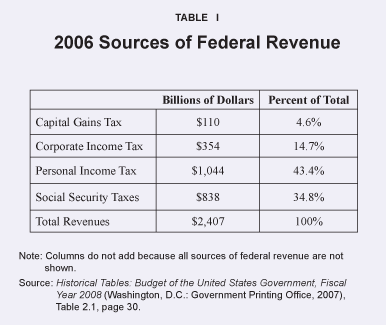
“Taxes on capital gains are a minor source of federal revenue.”
Another inequity of the tax is that individuals are permitted to deduct only a portion of the capital losses they incur, whereas they must pay taxes on all of the gains. That introduces an unfriendly bias in the tax code against risk-taking.3 When taxpayers undertake risky investments, the government fully taxes any gains realized if the investment has a positive return. But the government allows only a partial tax deduction (of up to $3,000 per year) if the venture goes sour and results in a loss.
At least one other large inequity of the capital gains tax is that it represents a form of double taxation on capital formation. This is how economists Victor Canto and Harvey Hirschorn explain the situation:
A government can choose to tax either the value of an asset or its yield, but it should not tax both. Capital gains are literally the appreciation in the value of an existing asset. Any appreciation reflects merely an increase in the aftertax rate of return on the asset. The taxes implicit in the asset’s aftertax earnings are already fully reflected in the asset’s price or change in price. Any additional tax is strictly double taxation.4
“Some state capital gains taxes add more than 50 percent to the federal tax.”
Take, for example, the capital gains tax paid on pharmaceutical stock. The value of that stock is based on the discounted present value of all the company’s future proceeds. If the company is expected to earn $100,000 a year for the next 20 years, the sales price of the stock will reflect those returns. The “gain” that the seller realizes from the stock’s sale will reflect those future returns, causing the seller to pay capital gains tax on the future stream of income. But the company’s future $100,000 annual returns will also be taxed when they are earned. So the $100,000 in profits is taxed twice — when the owners sell their shares of stock and when the company actually earns the income. That is why many tax analysts argue that the most equitable rate of tax on capital gains is zero.5 
In addition to the federal tax levy on capital gains, many states impose their own capital gains tax (see Table II). In California, Iowa and New Jersey, the combined federal-state capital gains rate can reach around 24 percent.
[page]In 1997 President Bill Clinton and a Republican Congress reached an agreement to lower the capital gains tax from 28 percent to 20 percent. According to Congressional Budget Office tax collection data, in 1996, the year before the capital gains tax rate cut, the total amount of net capital gains on assets sold was $335 billion. A year later, capital gains had jumped to $459 billion. (The tax cut was retroactive to May 1997.) In 1998 they climbed to $562 billion. In 1999, total capital gains exceeded $669 billion. A similar process occurred with the 2003 reduction; in 2002, realizations were at $301 billion; by 2006, they reached $683 billion.6
“More assets were sold, and federal revenues soared, after the 1997 and 2003 tax cuts.”
Of course, a big part of this surge in realized capital gains was a result of the stock market gains in the late 1990s and then in the 2003-2006 period. When the stock market high-technology bubble burst in 2000, capital gains realizations and revenues declined sharply. But the capital gains tax means that the after-tax rate of return on stocks rises, so the value of the stock market is inversely affected by the rate of taxation on capital gains. The two events, a higher stock market and the lowering of the capital gains tax, are not independent phenomena.
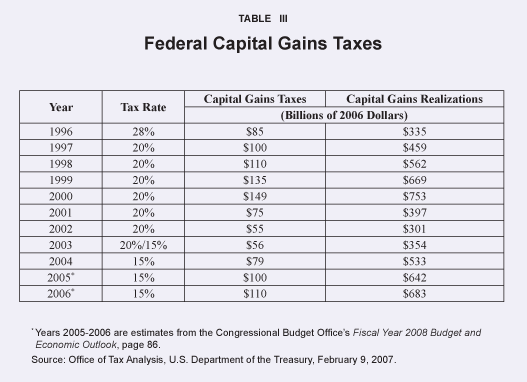
The CBO data also indicate that capital gains revenues have exploded. In 1996, the last year with the 28 percent rate, the government collected $85 billion in capital gains receipts. Table III shows what has happened since.
It is clear from these data that the lower tax rates changed people’s behavior, stimulated economic growth and thus created more, not less, tax revenues. This was neither a temporary, one-year effect, nor a historical aberration.
After the 1981 capital gains cut from 28 percent to 20 percent, capital gains revenues leapt from $30 billion in 1980 to $38 billion by 1983 — a 27 percent increase. More importantly, slashing the income and capital gains tax rates in 1981 helped launch what we now appreciate as the greatest and longest period of wealth creation in world history. In 1981 the stock market cratered at about 1,000, compared to 13,500 today.
Conversely, the perverse action in 1986 of raising the capital gains tax rate caused total asset sales of taxable capital gains to evaporate from $603 billion in 1986 to $283 billion in 1989.
[page]How is it that lowering capital gains taxes leads to more revenues? As noted before, the capital gains tax is a voluntary and easily avoided tax. When the tax rate is high, investors simply delay selling assets — stocks, properties, businesses and so forth — to keep the tax collector away from their door. When the capital gains tax is cut, asset holders are inspired to sell. Moreover, because a lower capital gains tax substantially lowers the cost of capital, it encourages risk-taking and causes the economy to grow faster, thus raising all government receipts in the long term. So the torrent of new revenues into government coffers was really no mystery at all; in fact, it was predictable.
“The capital gains tax is voluntary — investors can avoid it by holding on to assets.”
An Increase in Tax Revenues. There are now at least three years of data to test the effect of the capital gains tax on capital gains receipts. Figure I shows that from 2002 through 2005, capital gains receipts nearly doubled (from $55 billion to $100 billion). The latest estimate for receipts in 2006 is $110 billion.7 This is an increase of more than a 100 percent over four years.
These gains in tax receipts were not expected by the Congressional Budget Office and the Joint Committee on Taxation, which officially score tax changes. Figure I compares capital gains revenues with the forecast made when the tax cut was proposed. Again, a lot of the increase was due to the sizzling stock market over the past three years. But a lower capital gains rate increases the after-tax return on capital, helping create the strong market.
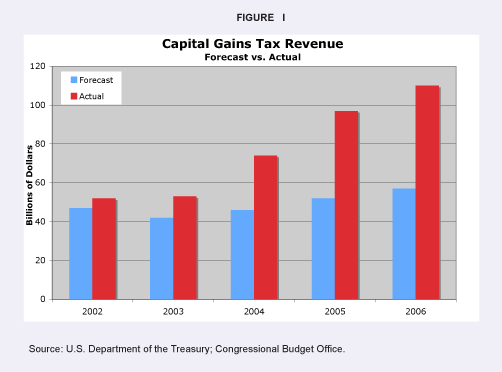
The lesson here is that the impact of tax changes cannot be properly predicted without assessing how the tax policy changes will influence the behavior of workers, entrepreneurs and investors. The static economic models used by the Joint Tax Committee and the Congressional Budget Office have had limited predictive powers.
Stimulating Investment and Capital Formation. Virtually all economists agree that capital formation is an essential component of a strong U.S. economy. So it is worth investigating whether the 2003 tax cut had a positive effect on the rate of business investment and capital formation.
In theory, one would expect lower capital gains tax rates to inspire a chain reaction of greater investment spending and higher asset values. When Congress chops the capital gains tax, it increases the after-tax rate of return on real assets (like plant, equipment and technology), and thus the value of the stock rises. Remember: a capital gains tax is merely a punitive second layer of tax; the value of a capital asset is no more nor less than the discounted present value of the revenue stream it produces. A rational tax system would tax the income stream or the asset value, but not both.
“Capital gains revenues more than doubled over four years, following the 2003 tax cut.”
U.S. industry experienced a rise in the cost of capital as a result of changes in the 1986 Tax Reform Act. Although a number of factors (including the institution of the corporate alternative minimum tax, changes in depreciation allowances and elimination of the Investment Tax Credit) have contributed to rising capital costs in the United States, one of the most important tax penalties on capital was the hike in the capital gains tax.8 Altogether, the added tax burdens imposed on capital investments in 1986 widened the gap between the income derived from a capital project, such as investment in a new plant, and the after-tax return to the firm and its stockholders.
America’s unfavorable tax treatment of capital investment after 1986 caused an observable slowdown in the rate of growth in U.S. capital formation. Between 1986 and 1992, business fixed investment fell by half. Business investment in equipment fell by one-third over the same period. Investment rebounded somewhat beginning in 1992, but really accelerated with the 1997 cut.
After falling again at the beginning of the current decade, investment increased sharply following the 2003 tax cut, as shown in Figures II and III. Business investment experienced a U-turn. For two years, 2001-02, business investment in equipment and software was negative, but in 2003-06 the numbers were highly positive, with an average annual increase in business investment of more than 10 percent.
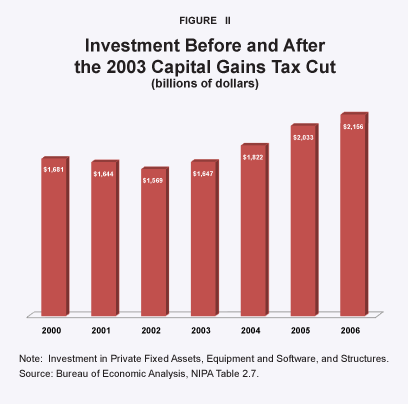
“Lower tax rates reduced the cost of capital, spurring investment.”
Many of the economic models had predicted this recovery in business capital spending. For example, the model for a U.S. Chamber Foundation study, which estimated the impact of rolling back the capital gains tax to 15 percent, predicted that the cost of capital to the corporate sector and noncorporate business sector would fall, and the tax-exempt bond rate would rise.9 The researchers found that those economic responses to the tax cut would have the following consequences for capital formation:
The size of the business capital stock, both corporate and non-corporate, expands relative to the size of the capital stock devoted to housing and consumer durables and to state and local capital. In the present model with a fixed aggregate capital stock, these results imply that the business capital stock increases and the other elements of the capital stock decline. In a growth context, of course, the business capital stock would simply grow faster than other components of the capital stock.10
That is almost exactly what did happen after 2003. The evidence supports the supply-side theory that lower capital gains rates stimulate more capital investment and growth.
Improving U.S. Global Competitiveness. One indication of which nations will prosper economically in the future and which will fall behind is the flow of international capital. In the 1980s, after marginal income tax rates were reduced by more than one-third, the United States attracted a net of nearly one-half trillion dollars of foreign capital. That is, foreigners invested $520 billion more in the United States than U.S. citizens and companies invested abroad. In recent years, nations have dramatically cut tax rates to become more competitive. The average income tax rate is 20 percentage points lower than in 1985 and the average corporate tax rate is almost 25 percentage points lower.
“Investment in technology (net of depreciation) went from negative to positive.”
How does the U.S. capital gains tax rate compare with that of other nations? Today the United States, even with the 2003 rate cut, still has a higher capital gains tax than many industrial nations. Table IV shows that many of America’s principal trading partners have lower rates on capital gains than the United States. In fact, many of our major international competitors — including Germany and Switzerland — impose no tax on long-term capital gains. Australia and the United Kingdom have higher capital gains tax rates, but because both those nations allow for indexing the value of the base asset to account for inflation, the effective tax rate may still be lower than the U.S. tax rate.
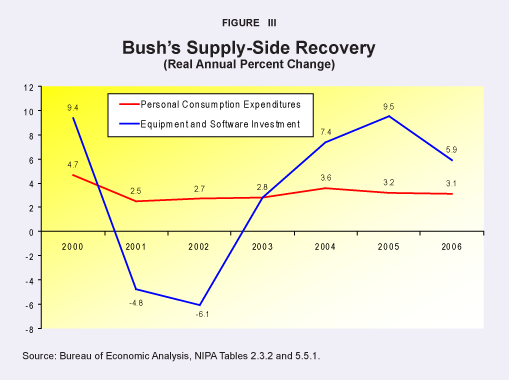
What is of even greater concern is that if the United States were to repeal the Bush tax cuts, the U.S. capital gains rate would be well above the international average, according to data from the American Council for Capital Formation. As Figure IV shows, returning to the 20 percent capital gains rate might repel foreign direct investment in America by increasing the cost of investment here.
[page]“Tax cuts encourage revenue-increasing activity.”
The impact of a capital gains tax cut on federal revenue collections has long been an issue of contentious debate — both in the academic literature and in public policy circles. In the current era of emphasis — at least rhetorical emphasis — in Washington on maintaining a surplus and paying down debt, it is predictable that the budgetary effect of capital gains tax changes would dominate public discussion.
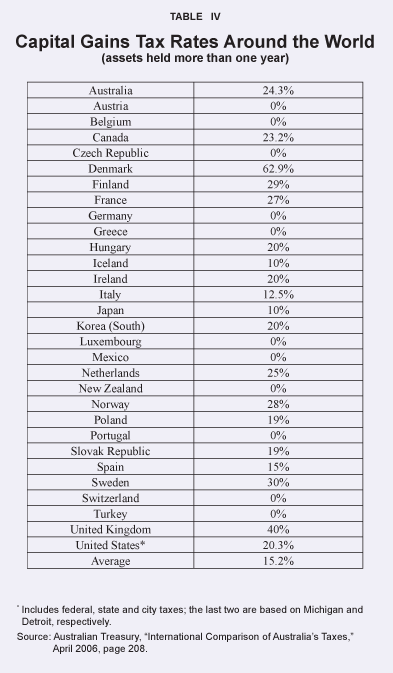
In theory, a capital gains tax cut would create several countervailing positive and negative revenue effects. The revenue-losing effects are:
- A static revenue loss from asset sales that would have occurred without the tax cut but benefit from the lower rate;
- A reduction in trading in anticipation of changes in the tax rate, as was witnessed in 1986; and
- A paper shifting of reported income from ordinary sources — such as wages taxed at the “normal” rate — to capital gains income with lower rates.
The revenue-gaining effects are:
- A short-term unlocking of assets that would not have been sold otherwise (and might never have been sold, but instead bequeathed at death);
- An increase in reporting of income (that is, less tax evasion);11
- An increase in the value of stock and other capital assets traded over the long run; and
- An increase in long-term economic growth from the higher capital formation, which would raise tax collections from income taxes, payroll taxes and other sources.
“Germany, Switzerland and many other countries do not tax capital gains at all.”
The issue is: Which effects dominate — the revenue-losing ones or the revenue-gaining ones? Unfortunately, there is no consensus answer to that question in the academic literature and the economic modeling forecasts.
Regression analysis has validated statistically that the 1969 rate increase lost revenue, the 1978, 1981 and 1997 rate reductions gained revenue, and the 1986 rate hike lost revenue.12 But the idea that lower rates generated higher revenues is by no means universally accepted. A time-series regression analysis by Urban Institute economist Joseph Minarik contradicts the favorable assessment of the 1978 and 1981 tax cuts. According to Minarik,
The 1978 law experience gives no backing to claims of an ongoing revenue pickup [from the tax cut]… The 1981 capital gains tax cut was a revenue loser from day one. The heart of the issue is revenue. And here there is no doubt.13
“If rates return to 20 percent, the United States will have higher capital gains taxes than most developed countries.”
“Government revenues rose after every capital gains tax cut of the last 30 years.”
The only truly reliable predictor of the future is the past. And here the evidence is fairly straightforward. Over the past 30 years a consistent pattern has emerged: every time the capital gains tax has been cut, capital gains tax revenues have risen. Every time the capital gains tax has been raised, capital gains tax revenues have fallen. Here are some prominent examples:
- In 1968, real capital gains tax receipts were $34 billion at a 25 percent tax rate. Over the next eight years the tax rate was raised four times, to a high of 35 percent. Yet with the tax rate almost 10 percentage points higher in 1972 than in 1968, real capital gains tax revenues were only $27 billion — 21 percent below the 1968 level.
- In 1978, when the top marginal tax rate was 35 percent, $28 billion in capital gains taxes were collected. By 1984, after the tax had been cut to 20 percent, revenues from the lower tax rate were $41 billion — 46 percent above the 1978 level.
- In 1986, the tax rate increased by 40 percent, from 20 to 28 percent. Did tax revenues climb by 40 percent? Just the opposite occurred. In 1990, the federal government took in 13 percent less revenue at the 28 percent rate than it did in 1985 at the 20 percent rate. In 1991 (and again in 1992), the government collected more than 15 percent less revenue than it did in 1985.
- In 1996, the year before the capital gains tax rate was cut from 28 to 20 percent, net capital gains on assets sold were roughly $335 billion. A year later, capital gains had leapt to $459 billion. (The tax cut was retroactive to May 1997.) In 1996 the Treasury collected roughly $85 billion in capital gains revenues. In 1997 those tax payments soared to $100 billion. As Table V shows, capital gains revenues for the period from 1997 to 2000 were nearly double what they were during the preceding period.14
- After the 2003 capital gains tax cut, federal revenues increased in four years by $740 billion. The budget deficit fell from $401 billion in 2004 to $160 billion in 2007. Capital gains revenues increased from $55 billion in 2002 to an estimated $110 billion for 2006. Every indicator shows that the 2003 investment tax cuts helped increase growth, stock market values and federal tax receipts.15
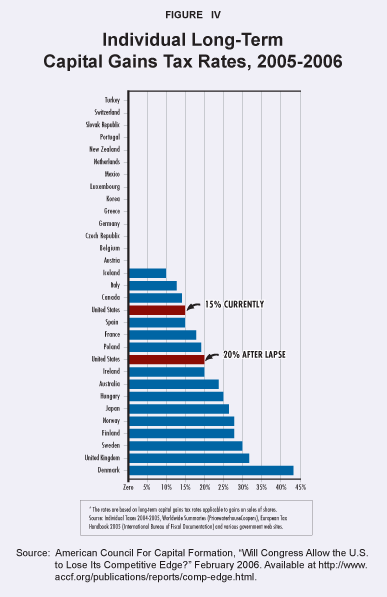

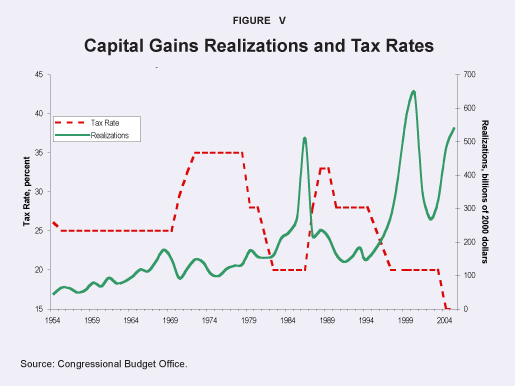
The major explanation for the lower tax collections at higher tax rates is the lock-in effect described earlier.16 Even opponents of a capital gains tax cut generally concede that there is a lock-in effect. The Congressional Budget Office recently stated, “There is strong evidence that realizations of capital gains decline when tax rates on gains are increased.”17 Figure V shows the inverse relationship between capital gains realizations and capital gains tax rates from 1954 to 2005.
“Capital gains ‘locked in’ due to high tax rates were realized due to tax rate cuts.”
Figure VI illustrates the lock-in effect differently. It shows, for 1954 through 1990, the ratio of total capital gains earned each year to the amount of those gains that was realized.18 The figure shows that when the capital gains tax rate is low, the ratio of unrealized capital gains falls (that is, investors are more likely to sell their assets). After the increases in the capital gains taxes in the late 1960s and early 1970s, the unrealized capital gains ratio rose from about 35 percent to almost 60 percent. After the 1978 and 1981 tax cuts, the 60 percent ratio tumbled to a 40-year low in 1986 of 20 percent. By 2000, the ratio was back up to 45 percent.19
“More ‘locked in’ assets were sold after rate cuts.”
So again we ask: Why is it that revenue estimators continue to overstate revenue losses and underestimate the unlocking effect from a lower capital gains tax rate? Alan Reynolds, chief economist with the Cato Institute, explains the consistently misguided forecasts. Reynolds notes,
All of the many studies of the revenue effect of the capital gains tax simply assume that there is no effect at all on the price of stocks and bonds, and also no effect on business investment or real GNP. That is, the revenue estimators ignore the most important effect.20
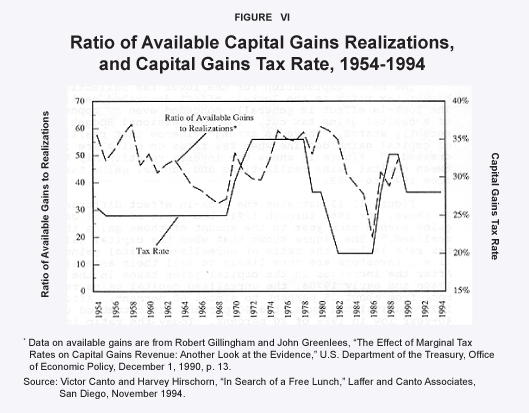
If the government revenue forecasters were to incorporate even modest economic growth responses into their static models and appropriately estimate the lock-in effect, the computers would spew out substantially different conclusions. That was the finding of a recent analysis by economist Martin Feldstein of the National Bureau of Economic Research on the sensitivity of government models to changes in economic growth. Feldstein concludes that if:
the improved incentives for saving, investment and entrepreneurship were to increase the annual growth rate of GNP [over five years] by even a microscopically small four one-hundredths of 1 percent — for example, from the CBO’s estimate of an average 2.44 percent real GNP growth per year to 2.48 percent — the additional tax revenue would be about $5 billion a year and would turn CBO’s estimated revenue loss into a revenue gain. In short, the potential economic gains from a capital gains [tax] reduction are substantial and the potential revenue loss is doubtful at best…The slightest improvement in economic performance would be enough to turn [CBO’s] revenue loss into a revenue gain.21
“Government revenue estimates ignore the incentive effects of tax cuts.”
In sum, if one accepts the notion that a capital gains tax cut promotes economic growth (as, once again, the evidence suggests was the case after the 2003 rate cut), then revenue losses from lower capital gains taxes will be much lower than anticipated. In some cases the lower capital gains tax generates more revenues.
[page]For nearly three decades, the so-called tax fairness issue has dominated the capital gains tax debate. Who are the winners and who are the losers from a capital gains tax cut? Every new analysis seems to provide a different answer to that question.
For example, when President Bush proposed the reduction in the capital gains rate in 2003, his critics argued that about 60 percent of the tax break would go to the richest 1 percent of Americans. But if we start by looking at the impact of the investment tax cut as a whole, we find that the share of taxes paid by the richest 1 percent and 5 percent of Americans actually increased after the tax cuts were enacted [see Table VI]. In 2005, the percentage of income taxes (which includes dividends and capital gains) paid by the richest 1 percent hit an all-time high of 39 percent. The top 5 percent paid nearly 60 percent of the income tax, close to an all-time record.
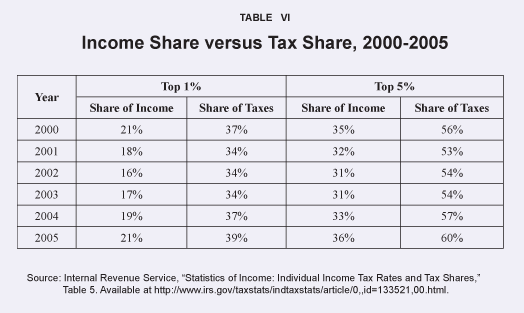
Thus, the 2003 tax cuts continued the trend of the 1990s of increasing the share of income taxes paid by the wealthiest taxpayers [see Figure VII].
“The share of taxes paid by the rich has risen.”
Examining just the taxes on capital gains, one finds that although the wealthy pay the most in capital gains taxes, millions of middle-income Americans claim capital gains on their tax returns as well. In fact, 2005 Internal Revenue Service data indicate that 47 percent of all returns reporting capital gains were from households with incomes below $50,000 [see Figure VIII]. Seventy-nine percent of all returns reporting capital gains were for households with incomes below $100,000 and half had incomes below $50,000.22 Moreover, these tax return data overstate the income status of those with capital gains, since these sales of assets are often irregular or even once-in-a-lifetime events. For example, when someone sells a home or ranch, the income from the sale may be $1 million, but the seller may have never earned more than $50,000 in his working life. He appears “rich” in the income statistics because of the cash from the one-time sale.
In the public finance literature, that is called “bunching.” Minarik of the Urban Institute writes:
The bunching problem arises when a taxpayer realizes a long-term gain relative to his average income. Such a taxpayer bears a far higher liability on that gain upon realization than he would under accrual taxation or a proration or averaging provision.23
“Nearly four-fifths of households reporting capital gains have incomes less than $100,000 and half have incomes below $50,000.”
Studies have found that the bunching problem creates an illusion that capital gains taxpayers are wealthier than they are in reality. A more meaningful measure of income, for the purposes of examining the equity effects of capital gains taxes, is “recurring income” — that is, income received on a regular or recurring basis. When income tax data excluding income from capital gains are examined, the share of capital gains income appears to be much more evenly distributed. In 1985 only one-quarter of all capital gains were realized by those with incomes above $200,000, excluding the capital gains income. Forty-five percent of the gains went to Americans with non-capital-gains incomes below $50,000.
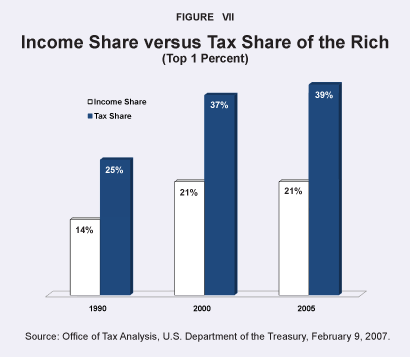
Until recently, the bunching problem had long been recognized by policymakers and tax experts as a convincing justification for a capital gains differential. A 1923 House of Representatives report on capital gains taxes identified the full taxation of capital gains as “an injustice to the taxpayer, in that an investment frequently accumulated over a period of many years was . . . arbitrarily attributed to the year the sale took place.”24 The introduction of a differential tax rate for capital gains three-quarters of a century ago was heralded as a victory for tax fairness. Similarly, in 1982 the CBO argued that one rationale for the then-60 percent exclusion of long-term capital gains was “to reduce the burden on a taxpayer that occurs when a capital gain accruing over several years is realized, requiring the taxpayer to pay tax at progressive rates on several years’ income all in one year.”25
“High capital gains taxes punish the elderly, not the rich.”
Bunching is most common among people entering retirement. A large percentage of capital gains beneficiaries are the elderly, who wind up selling a family business or a portfolio of stock that has accumulated over the individual’s working life and is meant to serve as a nest egg for retirement. The elderly are two and a half times more likely to realize capital gains in a given year than are tax filers under the age of 65. The elderly are also likely to derive a larger share of their income from capital gains than are younger workers. A study by the National Center for Policy Analysis examining IRS data from 1986 found that the average elderly tax filer had an income of $31,865, 23 percent of which was capital gains. The average nonelderly filer had an income of $26,199, 9 percent of which was from capital gains.26 Hence, the high capital gains tax rates punish the elderly, not the rich. The high tax rate is also a severe penalty against couples who have frugally saved during their working years to sustain themselves during retirement.
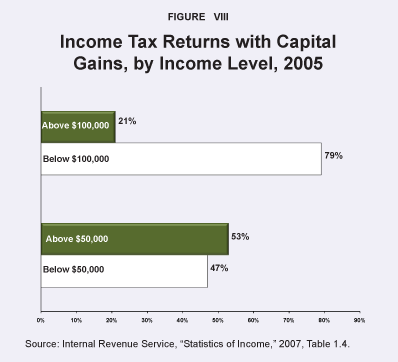
One of the most unfair features of the capital gains tax, noted briefly earlier, is that it taxes gains that may be attributable only to price changes, not real gains. The capital gains tax, unlike most other elements of the U.S. tax code, is not indexed for inflation, and that can have major distortional effects on what an individual pays in capital gains taxes. According to the nonpartisan Tax Foundation it can — indeed, often does — lead to circumstances in which investors “pay effective tax rates that substantially exceed 100 percent of their gain.”27
“Inflation causes illusory gains in asset prices.”
Figure IX, from a Tax Foundation report, shows the tax on real gains compared to inflationary gains on a stock purchased in 1956 and sold in each successive year. The Tax Foundation has found that about $50 billion a year of capital gains in the past decade, or about 20 percent to 25 percent of total gains, have been due purely to inflation.28 It found that in some years during the late 1970s and early 1980s, 100 percent of the gains were due to inflation. This inflationary effect is one reason that capital gains are taxed at a different tax rate than ordinary income. The lower rate on capital gains offsets some, but usually not all, of the phantom gains due to inflation.
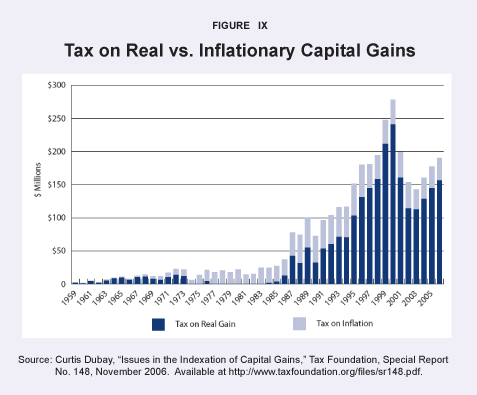
It is not at all uncommon for taxpayers to pay very high real capital gains tax rates. Then-Federal Reserve Board governor Wayne Angell calculated in 1993 that the average real tax rate on investments in NASDAQ stocks from 1972 to 1992 had been 68 percent.29 The real tax rate on investments in the Standard & Poor’s Composite Index over the same time period had been 101 percent. The average real tax on a portfolio of New York Stock Exchange stocks was 123 percent. And the average real tax on the Dow Jones Industrial Average over that 20-year period was an astounding 233 percent. In other words, according to three of the four indices, investors paid capital gains taxes on investments that actually lost money after adjusting for inflation — and thus the tax simply diminished the principal. Angell concluded,
[page]If we are to reduce the damaging effects that we know are caused by all capital taxation, it makes sense to eliminate the worst aspect of the most damaging tax on capital — the tax on phantom gains. The tax on real capital gains is a middle-of-the-road bad tax. But the tax on nominal capital gains without regard to whether the gain is real or only the effect of inflation is truly the worst tax.30
“Lower capital gains tax rates increase asset values and encourage investment.”
By every objective measure, the 2003 capital gains tax cut has had positive economic and fiscal effects. Even the argument that the capital gains tax change would only benefit rich people has been proven to be inaccurate given that more than half the tax returns with capital gains income are from filers with adjusted gross incomes of $50,000 or less. Whether the tax cut will pay for itself in the long term is an open question, but what is irrefutable is that the capital gains cut, so far, has increased collections from this tax after four years. The stock market and real estate market booms have been the major factors in the doubling of capital gains revenues, but the higher asset valuations have been partly due to investors seizing on the lower taxes on capital assets.
The Treasury Department recently provided a concise summary of the 2003 capital gains cut experience:
The lower tax rates on dividends and capital gains lower the cost of equity capital and reduce the tax biases against dividend payment, equity finance and investment in the corporate sector. All of these policies increase incentives to work, save and invest by reducing the distorting effects of taxes. Capital investment and labor productivity will thus be higher, which means higher output and living standards in the long run.31
The Treasury’s analysis is by no means a modern revelation. In 1963 President John F. Kennedy clearly understood the fundamental importance of capital investment’s role in the economy:
The tax on capital gains directly affects investment decisions, the mobility and flow of risk capital . . . the ease or difficulty experienced by new ventures in obtaining capital, and thereby the strength and potential for growth in the economy.32
“Congress should permanently reduce taxes on capital gains.”
Finally, circumstantial evidence suggests that the political uncertainty of the direction the capital gains tax is headed may now be hurting the stock market and reducing the value of U.S. assets, which may be exacerbating the dollar’s fall relative to the euro and other currencies. After 2010, the capital gains tax is scheduled to rise back to 20 percent. This reduces the value of stocks today, because the after-tax rate of future returns on stocks is lower with the possibility of this coming tax hike. Moreover, the Wall Street Journal reports that investors are already beginning to sell stocks and other assets in anticipation of the higher tax rate in 2011.
In our opinion, it is not only critical that Congress extend the life of the tax cuts by making them permanent, but also vital to do so sooner rather than later. This would help boost the economy now and reduce the bearish nature of economic and fiscal policy uncertainty.
NOTE: Nothing written here should be construed as necessarily reflecting the views of the National Center for Policy Analysis or as an attempt to aid or hinder the passage of any bill before Congress.
[page]- Jude Wanniski, “Capital Gains in a Supply Side Model,” testimony before the Senate Finance Committee, March 15, 1995.
- Alan S. Blinder, “The Level and Distribution of Economic Well-Being,” in Martin Feldman, ed., The American Economy in Transition (Chicago: University of Chicago Press, 1980), page 48.
- Congressional Budget Office, “Indexing Capital Gains,” August 1990.
- Victor Canto and Harvey Hirschorn, “In Search of a Free Lunch,” Laffer and Canto Associates, San Diego, Calif., November 1994.
- See, for example, Norman B. Ture and B. Kenneth Sanden, The Effects of Tax Policy on Capital Formation (New York: Financial Executives Research Foundation, 1977); Wanniski, “Capital Gains in a Supply Side Model;” and Raymond Keating, “Eliminating Capital Gains Taxes: Lifeblood for an Entrepreneurial Economy,” Small Business Survival Committee, Washington, D.C., 1995.
- Congressional Budget Office, “The Budget and Economic Outlook: Fiscal Years 2008-2017,” January 2007. Available at http://www.cbo.gov/ftpdocs/77xx/doc7731/01-24-BudgetOutlook.pdf.
- Figures adjusted for inflation to constant 2006 dollars.
- Mark Bloomfield, American Council for Capital Formation, testimony before the Senate Committee on Finance, February 15, 1995.
- The research was conducted by economists Patrick Hendershott and Yunhi Won of Ohio State University with Eric Toder of the Treasury of New Zealand. The researchers employed a modified version of the General Equilibrium Model of Differential Asset Taxation, which attempts to capture the effect on various types of capital investment of changes in the tax treatment of various assets and differences in marginal tax rates among taxpayers. The General Equilibrium Model of Differential Asset Taxation is a sophisticated simulation computer model of the economy. It incorporates four major capital-using sectors: corporations, noncorporate businesses, state and local governments, and 147 separate household sectors. The particular assets held by those sectors are sensitive to the after-tax yields on investments, the riskiness of the assets and a measure of risk aversion. The model also contains a detailed representation of the major elements of personal and corporate tax laws, thus allowing the researchers to measure how capital is allocated in response to various changes in the tax code — in this case, a reduction in capital gains taxes.
- Hendershott, Won and Toder, “Economic Efficiency and the Tax Treatment of Capital Gains,” National Chamber Foundation, Washington, D.C., 1990.
- A study by economist James Poterba finds that “a 1 percent change in the marginal tax rate leads to a 1 percent change in reported income, so even without any change in the true tax base, capital gains tax cuts would be essentially self-financing.” James M. Poterba, “Tax Evasion and Capital Gains Taxation,” American Economic Review, May 1987.
- On the effect of the 1969 rate increase, see Gerald Auten, “Empirical Evidence on Capital Gains Taxes and Revenues,” U.S. Department of the Treasury, 1979; and Gary Brannon, “The Lock-in Problem for Capital Gains: An Analysis of the 1970-71 Experience,” in The Effect of Tax Deductibility on the Level of Charitable Contributions and Variations on the Theme (Washington, D.C.: Fund for Policy Research, 1974).
On the effects of the 1978 and 1981 rate reductions, see Michael R. Darby, Robert Gillingham and John S. Greenlees, “The Direct Revenue Effects of Capital Gains Taxation: A Reconsideration of the Time-Series Evidence,” Treasury Bulletin, June 1988.
On the 1986 rate hike, see Lawrence B. Lindsey, “Capital Gains Taxes under the Tax Reform Act of 1986: Revenue Estimates under Various Assumptions,” National Bureau of Economic Research, Working Paper No. 2215, April 1987.
On the 1997 rate cut, see Stephen Moore, “Capital Gains Tax Cuts Aren’t Just for the Rich,” Wall Street Journal, July 15, 1999. - Joseph J. Minarik, “The New Treasury Capital Gains Study: What Is in the Black Box?” Tax Notes, June 28, 1988.
- House Policy Committee, “2000 Annual Report to Taxpayers.” Available at http://policy.house.gov/annreport/2000/charts.html.
- Office of Tax Analysis, Department of the Treasury. February 9, 2007; *Years 2005-2006 are estimates from the Congressional Budget Office’s FY2008 Budget and Economic Outlook.
- See Martin Feldstein, Joel Slemrod and Shlomo Yitzhaki, “The Effects of Taxation on the Selling of Corporate Stock and the Realization of Capital Gains,” Quarterly Journal of Economics, June 1980.
- Congressional Budget Office, “How Capital Gains Tax Rates Affect Revenues: The Historical Evidence,” 1988, page xi.
- Canto and Hirschorn, “In Search of a Free Lunch.”
- Canto and Hirschorn estimate that the economic impact of the current investment lock-in is to raise the cost of new capital by 1.64 percent per year. They calculate that “unlocking the capital gains could increase household income between $115 [billion] and $230 billion per year” (page 6). That’s an increase in per-household income of $1,000 to $2,000.
- Alan Reynolds, “Time to Cut the Capital Gains Tax,” Supply Side Analytics, Polyconomics Inc., 1989.
- Quoted by American Council for Capital Formation.
- Internal Revenue Service, “Satistics of Income,” 2007, Table 1.4.
- Joseph J. Minarik, “Capital Gains,” in Henry J. Aaron and Joseph A. Pechman, eds., How Taxes Affect Economic Behavior (Washington, D.C.: Brookings Institution, 1981).
- Bloomfield, testimony of March 28, 1990.
- Ibid.
- John Goodman, Aldona Robbins and Gary Robbins, “Elderly Taxpayers and the Capital Gains Tax Debate,” National Center for Policy Analysis, 1990.
- Arthur Page Hall, “Issues in the Indexation of Capital Gains,” Tax Foundation, Special Report, April 1995.
- Curtis Dubay, “Issues in the Indexation of Capital Gains,” Tax Foundation, Special Report No. 148, November 2006. Available at http://www.taxfoundation.org/files/sr148.pdf.
- Wayne Angell, Governor, Federal Reserve Board, Statement before the Republican members of the Joint Economic Committee, June 22, 1993.
- Ibid.
- Office of Tax Analysis, The United States Department of the Treasury. A Dynamic Analysis of Permanent Extension of the President’s Tax Relief, July 25, 2006, page i. Available at http://www.treasury.gov/press/releases/reports/treasurydynamicanalysisreporjjuly252006.pdf.
- “A Capital Gains Primer,” Wall Street Journal, October 17, 2007; page A22. Available at http://online.wsj.com/article/SB119240927948858793.html.
Stephen Moore is a member of the editorial board and senior economics writer at the Wall Street Journal. Mr. Moore is the founder and former president of the Club for Growth and served as a senior economist for the Joint Economic Committee of Congress, as a budget expert for the Heritage Foundation and as a senior economics fellow at the Cato Institute, where he published dozens of studies on federal and state tax and budget policy. He was a consultant to the National Economic Commission in 1987 and research director for President Reagan’s Commission on Privatization. Moore is a graduate of the University of Illinois and holds a Master of Arts degree in economics from George Mason University.
Tyler Grimm is a research assistant with the Wall Street Journal. He studies government and international politics at George Mason University and has also attended Oxford University. Grimm was a Koch Fellow at the Reason Foundation in Washington, D.C., where he researched issues related to privatization and tax policy.